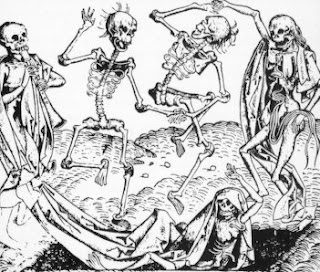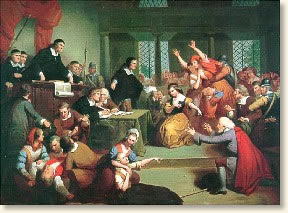In 1518, outside of Strasbourg, a married woman steps out of her house and begins to dance. She dances until she falls to the ground from exhaustion, only to get up and continue, her feet bruised and bloody. Soon other dancers join the streets, eventually including more than four hundred normally calm townsfolk who leap high into the air in their frenzy, continuing even as they ache and bleed, muscles torn from the bone. Some of those who fall at the end of the day never get up again.
 |
| Strasbourg Dancing Plague |
In ancient Greece a traditional drink was used to break the fast at the climax of Eleusinian Mysteries, kykeon, a drink that consistently introduced revelations and intense experiences in the participants.
In 1951, in a small, bluff-bound city in Southern France doctors are inundated by phone calls of patients complaining of cramps and fever that quickly escalate into convulsions and delirium. A small boy tries to choke his mother; two men rush through the streets on the run from invisible enemies; men die of convulsions screaming that their heads have turned to molten lead.
Throughout the Middle Ages entire villages succumb to “St. Anthony’s Fire,” so called because it is primarily treated by the Monks of St. Anthony. They paint their hospitals red to illustrate to the illiterate populace that here there are physicians who can treat those poor souls whose skin burns red and limbs rot off due to gangrene as they convulse, even if it was probably their sins that brought them to this state in the first place.
 |
| St. Anthony’s Fire |
In January 1692 two young girls, Betty Parris and Abigail Williams- the daughter of Salem Village’s minister and his orphaned niece- begin to have fits of convulsions, bizarre skin sensations, and begin to issue horrid blasphemies. When examined by the doctor no cause can be found for their behavior and it is announced that they are bewitched. This is the start of what is now infamously known as the Salem Witch Trials, a period which would end with 150 people accused of witchcraft, nineteen of which were hanged, four of which died in prison, and one of which was slowly crushed with stones over a period of two days.
What do all of these cases have in common? They all have been attributed, at one time or another, to a common staple of the poor: rye. Or, more specifically, rye gone wrong in the form of ergot.*
 |
| Rye bread! Boo! Hiss! |
Ergot is the common name of the fungus Claviceps purpurea which spreads by spores and infects grains, usually rye. It gets into developing kernels of grain, leaving them looking mostly normal, although they are larger and a strange purplish-black color.
But these grains are incredibly dangerous, containing alkaloids that affect the central nervous system and the muscles that line the walls of veins, arteries and internal organs. As a matter of fact, the chemicals present in ergot of rye are similar to those that make up LSD.
 |
| Ergot of Rye (sounds like some foreign prince, doesn’t it?) |
People who consume rye tainted by ergot develop a strange disorder marked by headache, vomiting, delusions, crawling sensations or burning and itching feelings of the skin, violent muscle spasms, psychosis and hallucinations. In severe cases patients can lose sensation in the peripheries and develop blisters and gangrene.
 |
| Well, these skeletons look jolly. |
The fungus thrives in warm, damp, rainy springs and summers, which happens to be the exact conditions of the spring and summer in Salem. And most of those who were taken by the supposed witchcraft lived in the swampy section of Salem Village and ate mostly rye.
Now the disease itself is perfectly natural. Anyone with the resources to track the infected and what they consumed could make the connection between the tainted rye and the illness. But here was a disease that caused seemingly healthy people to suddenly hallucinate and shout at invisible enemies all while complaining of fiery, crawling feelings on their skin. It’s a disease that seemingly struck at random, affecting one individual within a family, and not seemingly spreading like the cold or flu would in dense environments. The doctors of the time might know how to treat it, like the monks of St. Anthony’s, but they couldn’t pinpoint the cause.
With little help from the medical community it was hard for people in Salem and elsewhere to see these cases as anything other than divine punishment or the work of the devil. And when your victims are, as in the case of Salem, young protectorates of the minister, it is easy to see how the community was quick to blame witches.
Now, of course ergot of rye can’t be the only explanation for these cases. As the Witch Trials progressed it’s unlikely that ergot poisoning continued to be the cause as much as mass hysteria. Linnda Caporal, one of the first scientists to make the connection between ergot poisoning and the symptoms of the bewitched in Salem admits that “At the end of June and the beginning of July, 1692 I think there was more imagination than ergot. But by that point in time three people have already been hung, and the trials had taken a path that people felt they had to stay on.”
It’s also important to note that the Puritan society of Salem was one marked by deep currents of unrest. It was divided physically into Salem Town and Salem Village, with the Town being considerably well off and made up of merchants and businessmen. The Village was mostly made up of poor farmers, their prices set primarily by the businessmen, who tended to look askance on the decadent, material lifestyle of those in the Town. The Puritan faith itself was skewed to support men and male dominance, with women having very little power in society and, being as they were the source of original sin, not even allowed to speak the word of God.
 |
In an unequal society, with its members sexually repressed, angry at economic differences and fearful of the Native Americans nearby, it’s likely that the ergot only provided the stimulus to goad an already troubled community.
And although historians have championed the idea of ergot being the cause, when it comes to the dancing plague in Strasbourg John Waller, author of The Dancing Plague, makes a strong case that it was probably not the source. He argues that while ergot of rye can cause convulsions and delusions, it is unlikely that it could cause “rhythmic movements lasting for days. And the agreement of chroniclers, physicians and clergymen is emphatic: the people danced.” He also brings up the fact that ergot poisoning tends to also cause gangrene and awful burning sensations, neither of which were noted in Strasbourg.
When it comes down to it, most of the evidence for ergot poisoning in any of these cases (excepting the case in 1951) is fairly circumstantial. But how intriguing the idea all the same that some of the most interesting cases in medical history can be traced to a single type of very bad grain.
*In the case of kykeon the culprit was probably not ergot infested rye as much as ergot infested barley, but the psychoactive properties are much the same in barley as in rye.



How dare you slander the good name of Rye bread!
*Libel
(sorry for the inaccuracy)
Buahahahaha. How did I miss this comment earlier?
Good sir, Rye is not to blame and I apologize for my ill-informed photographic caption above suggesting it was. I shall make my apologies to the families that I have thus wronged. But it was not really my fault, I was taken in by ergot's fancy name and swarthy manner, it tricked me into blaming rye!
Ergot rot is not hot! Thanks for the information. Do you have access to any pictures or ergot infecting other plants in seedling stage? i'm harvesting some Arundinaria soon and it is prone to ergot rot (which I assume is more fun to say than experience.) I will continue some research if there is any other information you have please just reply to my comment here 🙂
Grains Canada has some resources that might help:
http://www.grainscanada.gc.ca/str-rst/ergot/ecg-ecg-eng.htm
and I came across some great pictures at the University of Nebraska website here:
http://pdc.unl.edu/agriculturecrops/sorghum/ergot.
Hope those help you!